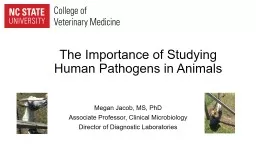

Human Pathogens in Animals Megan Jacob MS PhD Associate Professor Clinical Microbiology Director of Diagnostic Laboratories What are zoonotic pathogens Microorganisms from animals that can be shared and cause disease in people ID: 934321
Download Presentation The PPT/PDF document "The Importance of Studying" is the property of its rightful owner. Permission is granted to download and print the materials on this web site for personal, non-commercial use only, and to display it on your personal computer provided you do not modify the materials and that you retain all copyright notices contained in the materials. By downloading content from our website, you accept the terms of this agreement.
Slide1
The Importance of Studying Human Pathogens in Animals
Megan Jacob, MS, PhDAssociate Professor, Clinical MicrobiologyDirector of Diagnostic Laboratories
Slide2What are zoonotic pathogens? Microorganisms from animals that can be shared and cause disease in peopleViruses
BacteriaFungiParasitesVery common (6 of 10 infectious diseases in people)Animals do not necessarily appear sick when carrying zoonotic organisms
Reservoir for antimicrobial resistance that can be disseminated
Slide3Who’s at risk for zoonoses? Young children (< 5 years old)
Adults > 65 years old Immunocompromised Infectious diseasesImmune system dysfunctionCancer patients receiving chemotherapyPregnant women
Slide4Who’s at risk for zoonoses? Young children (< 5 years old)
Adults > 65 years old Immunocompromised Infectious diseasesImmune system dysfunctionCancer patients receiving chemotherapyPregnant women
15-20% of population in developed countries
Slide5Others?MalnutritionUse of antacids (proton pump inhibitors)
Increased circulating ironIngestion of fatty foodsIngestion of large volumes of waterTransplant recipients
Slide6Reasons for decreased immunity General immunosuppression Primary deficit in immune system, or using drugs that target immune system
reduction in the number of organisms needed to cause disease and increase the severity of illness
Slide7Is there more?
Slide8Hygiene Hypothesis
Slide9“Conclusions”Strong evidence ties the immune status with susceptibility to foodborne pathogens and zoonoses
Evidence that immune system function differs between those exposed to farm environments often and at an early ageIncreasing amounts of immunocompromised people may be visiting livestock interaction facilities
Slide10How are zoonotic pathogens shared? Direct contact with an animalIndirect contact
Ingestion of contaminated food or waterRaw milkDrinking waterUndercooked meatIngestion after contact with environment
Fence railsDoor knobs
Equipment Serving utensils
Animal bedding
Contaminated clothing or shoes
Slide11Role of environmental survival of pathogens Organisms that persist in the environment extend the time that people may be at risk for acquiring a zoonotic pathogen
Organisms that survive in the environment can be disseminated to new areasInsect vectorsRainwater runoffPhysical movementDustSome microorganisms remain stable in the environment, others proliferate
Slide12How well do zoonotic organisms survive in the environment?Highly variable between and even within different organisms
Influenza virus – short - minutesShiga toxin-producing E. coli (STEC) – reported > 300 days in sawdustSalmonella
– months in manure or wooden fencingCryptosporidium
- stage dependent; oocyte can survive months in water environment
Slide13Factors that influence environmental survival of zoonotic pathogensPresence of biological material (manure)Temperature
Humidity/MoistureAcidityType of microorganism
Slide14Bacterial biofilmsBiofilms are a group of microorganisms that stick to each other and usually to a surface. They are embedded in an extracellular matrix and behave differently then they would outside of the community
Slide15Examples of environmental persistence
Slide16Examples of environmental persistence
Slide17Slide18Current recommendations to control zoonotic pathogensControl shedding of organisms from animals
Control strategies?Testing strategies?Management strategiesStress, handling, transportation, season, age of animalProper manure disposalFacility design
Disinfect areas as possibleProvide ventilation
Limit animal use space for community events
Slide19Environmental persistence Cannot be predicted by organismMulti-factorial
Can be controlled with management strategies
Slide20NAHMS Organisms
OrganismExpected TurnaroundExpected Prevalence
Public Health ImportanceGeneric
E. coli3 days
60-70%
Mild
Shiga
-toxin
E. coli
(STEC)
5 days
10%
High
Salmonella
5 days
3-5%
Moderate*
Campylobacter
7 days
1-3%
Moderate*
Enterococcus
3 days
70-80%
Mild
Giardia/Crypto
Send
to MD – 3-5d
??
High
Slide21Questions?Megan Jacob
Department of Population Health & Pathobiology1060 William Moore Dr.Raleigh, NC 27607Megan_Jacob@ncsu.edu
(919) 513-6236